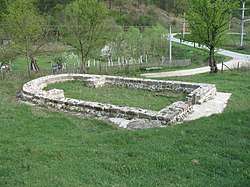Babe (Sopot)
Babe (Serbian: Бабе) is a village in the municipality of Sopot, suburban municipality of Belgrade, the capital of Serbia. According to the 2002 census, the village has a population of 332 people.[1]
Babe Бабе | |
|---|---|
Village | |
 Babe | |
| Coordinates: 44°31′N 20°31′E | |
| Country | |
| District | Belgrade District |
| Municipality | Sopot |
| Population (2002) | |
| • Total | 332 |
| Time zone | UTC+1 (CET) |
| • Summer (DST) | UTC+2 (CEST) |
Roman mines
In the early 2000, a new sports complex "Babe" was built. In July 2000, during the excavations for complex, a spring was discovered in the valley of the Pruten creek. The new Pruten spring has a capacity up to 40 l/s (530 imp gal/min) and by 2011 a waterworks was constructed which supplies the villages of Babe, Stojnik and Ropočevo, so as the complex itself, with the water from this spring. Moreover, during the excavation, a hidden entry into the vast complex of Roman mines was discovered, too, being obscured for centuries. There are evidence of the extraction of silver, iron and lead. In the 3rd century AD, the Kosmaj mines were one of the most important in the Roman Empire, and were administered by the Roman procurator Babenius, whose name is preserved in the name of the Babe village. In the 1970s and 1980s, experts from the National Museum in Belgrade explored the area and discovered many mining necropolis, centered around the villages of Babe, Stojnik and Guberevac. It is estimated that there are some 100 ancient mining shafts on Kosmaj, which go 2 km (1.2 mi) below the ground and are 25 km (16 mi) wide. After the Roman period, mining activities ceased, only being revived in the Medieval Serbia.[2]
Characteristics

In the 15th century, during the reign of Despot Stefan Lazarević, there was a church in the village, built by the local nobleman. The church was subsequently razed to the ground and after being left to the elements for centuries, the remains were reduced to rubble and the memory of the once existing church was erased. During the 2002 survey of the region by the experts from the Institute for the protection of the cultural monuments the foundations were discovered. In 2005 construction of the new church on the old foundations began. The stone building was finished in 2018. The churchyard has two gates and a drinking fountain. There are plans for a small konak in the yard for the nuns, as the plan is to turn the church into the female monastery.[3]
References
- Popis stanovništva, domaćinstava i Stanova 2002. Knjiga 1: Nacionalna ili etnička pripadnost po naseljima. Republika Srbija, Republički zavod za statistiku Beograd 2003. ISBN 86-84433-00-9
- Milan Janković (30 May 2011), "Voda kulja iz kosmajskih rudnika" [Water is pouring from the Kosmaj mines], Politika (in Serbian)
- Miroslav Stefanović (29 July 2018). "Реч дали, цркву саградили" [The word was given, the church was built]. Politika-Magazin, No. 1087 (in Serbian). p. 23.